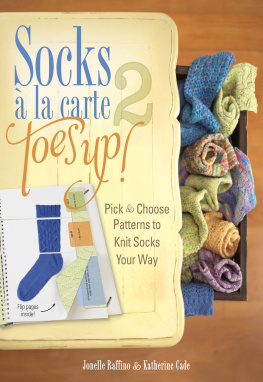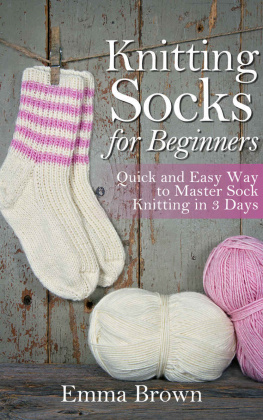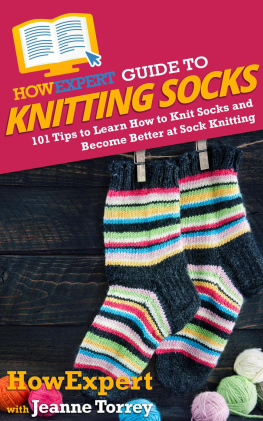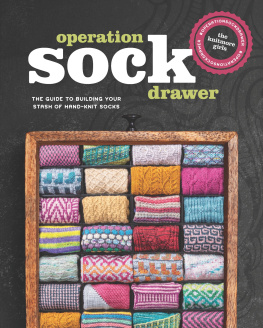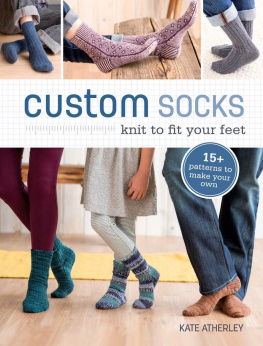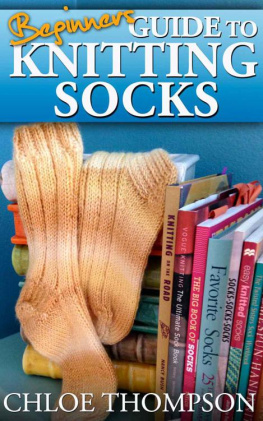
Knitting Socks
For The Absolute Beginner
Diane Dobson Barton
Artist How To
Knitting Socks
for theAbsolute Beginner
By Diane Dobson Barton
@Copyright Diane Dobson Barton
AHT Press: 2011, Second edition (2021)
Discover other titles by Diane Dobson Barton
http://dianedobsonbarton.com
This eBook is licensed for your personal enjoyment only.This eBook may not be resold or given away to other people. If you would like to share this book with another person, please purchase an additional copy for each recipient. If youre reading this book and did not purchase it, or it was not purchased for your use only, then please return to DianeDobsonBarton.com and purchase your own copy. Thank you for respecting the hard work of this author.
Contents
Introduction
Knitting Socks for the Absolute Beginner
Because the goal of this book is to learn how to knit socks, it is not a traditional knitting book. There are directions for one sock so you can go through it slowly step-by-step. This way you can learn the process before learning more ambitious designs.
A small-sock is a great first real project, or for a quick on the go project for those with more experience. If you know how to knit and purl, but have never knitted a sock before, or ever used double-pointed needles, it will feel strange at first. Keep in mind once you complete the first round or two, it becomes MUCH easier.
The part that seems to intimidate people that most is the turning of the heel. But once you can visualize what needs to be accomplished, it is doable for just about anyone.
This tutorial uses a set of four double-pointed needles. Three used to hold the stitches as you go around, and the fourth moving as you knit. You can, of course, use five and get the same results. But, they sell most needles in sets of four and using four gives you fewer needles to conquer, fewer is better for beginners.
We do not deal with gauging your stitches much in this eBook. The primary focus here is the structural knitting of the actual sock form. However, if you plan to create a precise fit, gauging is the best way to get it.
Objectives:
If you are new to knitting, I suggest you make a swatch to try out each of the stitches. No one else ever needs to see this, so dont be afraid of making mistakes. Consider it all practice and/or warming up to get ready. Start with the Long Tail Cast-On, then the knit and purl stitch, and finally learn how to bind off your yarn.
If you know the basics already and just want to learn how to create the parts of a sock, I suggest considering this one as your learning sock. Unwind the yarn whenever you want to relearn a specific area. The goal is to figure out how to make each part of the and how to go through each step successfully.
Supplies
One Skein of Finger- Weight Sock Yarn.
Size1 (2.25mm) Double-Pointed Needles - Set of four
Scissors
Crochet Hook or a Darning Needle
Needle Protectors (or small rubber bands to wrap over ends)
Stitch Holder (Optional)
Stitch Marker (Optional)
Gauge Checker (Optional)
Slip Knot
Place the end of the yarn in your left hand and wrap it around your index finger. Put the end of the yarn under the loop, as shown.
Pull the yarn over the other side of the loop. Bring the end of your yarn over and under another loop to form a slip knot.
Pull the knot tight and make sure you can move the knot back and forth along the yarn. If the knot does not move, it is not correct.
Long Tail Cast On
The method shown is the long-tail cast on; it is one of many ways to cast on stitches. I am right-handed and knit with the yarn held in my left hand. It also known this as Continental Style.
Cast on 40 stitches.
Place one of your DPN inside the loop.
Close the loop around the needle.
Wrap the yarn around your fingers as shown.
Bring the tip of the DPN up through the loop on your index finger.
Pull the new stitch tighter. Do not pull too tight or you wont be able to work the stitches. But you dont want it too loose either. The only way to learn the correct tension is through trial and error.
Repeat steps casting on until you have13 stitches on Needle #1
Try to keep your stitches uniform and on the left side of the needle. You can tell they are on the left side because you will see the slight bump of the stitch as shown on the left.
Hold the next needle close to the first and cast on new stitches until you once again have13. You can also put the total number of stitches on one needle and transfer them to the other needles.
Place the third DPN to the left and cast on another 14 stitches.
Next page

